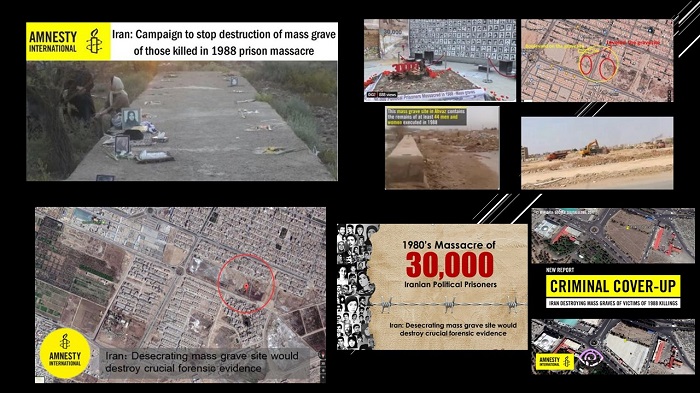
MEK Iran: Documentary report about the destruction of the mass grave of the 1988 massacre in Ahvaz.
The Iranian regime has destroyed a mass grave in Ahvaz, which contains the remains of many victims of the 1988 massacre, and intends to build a road over the top in order to destroy evidence of their heinous crimes.
Supporters of the People’s Mojahedin Organization of Iran (PMOI / MEK Iran) in Ahvaz and the wider Khuzestan province have created a documentary report about the destruction, which includes confirmation from a local truck driver that MEK members killed in the 1988 massacre of 30,000 political prisoners are buried beneath the area.
The #Iranian regime has tried to cover up its crimes by constructing a boulevard in this place. This has all happened because of the international attention recently focused on the 1988 massacre of political prisoners. https://t.co/NF9DVwlhjW
— StopFundamentalism (@SFundamentalism) September 13, 2020
The regime officials, however, are claiming that they are making improvements to the city’s infrastructure, with the hope that no foreign government or human rights organization pays too much attention to the razing and reconstruction.
There are dozens of mass graves all across Iran that contain the bodies of political prisoners, executed solely for their beliefs, and thrown into large pits in remote areas with no headstones to mark the site or even a registry of the dead. Most of the graves are from the period 1981-1988 when the regime was trying to maintain its shaky grasp on power and sought to crush a powerful opposition.
Over the past 40 years, the mullahs have tried repeatedly (and sometimes managed) to destroy these mass graves, which are the biggest source of evidence for the regime’s crime against humanity.
#Iran: Regime builds boulevard over gravesite of massacred PMOI/MEK members in Ahvaz#1988Massacrehttps://t.co/FTg4BBsVmN
— People's Mojahedin Organization of Iran (PMOI/MEK) (@Mojahedineng) September 12, 2020
As with this time, officials claimed that they were building roads to link to remote villages, because who would object to that? However, if you take a bird’s eye view, you can see that at least two sites had cement poured over in large square shapes, which is not how roads are built.
In May 2017, the regime attempted to build a road over some other mass graves in Ahvaz, but this was halted because the families of the victims objected heavily and the Iranian Opposition, The National Council of Resistance of Iran (NCRI), and the People’s Mojahedin Organization of Iran (MEK) launched an investigation. In June, authorities vowed not to touch the grave during road construction, but just one year later, they were up to their old tricks. In June 2018, the regime razed one mass grave in less than 24 hours with large machinery.
Other graves have been desecrated with rubbish, with the goal of preventing relatives from visiting at all.
Ahvaz is one of the most important locations for mass graves in Iran because it’s where the first group of executed political prisoners was buried in 1981.
Authorities in Iran destroy mass grave in Ahvaz where victims of the #1988Massacre are buried. @UNHumanRights must take urgent action https://t.co/gMlG3mAEhh @UN_HRC @FCOHumanRights @StateDRL @USAdarFarsi @nikkihaley @CanadaUNGeneva @UKMissionGeneva @AmnestyIran @FranceONUGeneve pic.twitter.com/nOHFIIvDKL
— Justice for the Victims of 1988 Massacre in Iran (@jvmifoundation) July 21, 2018
1988 massacre 30,000 political prisoners background
In 1988, the mullahs’ regime executed more than 30,000 political prisoners who were held in prisons across Iran. The massacre took place due to a fatwa issued by Ruhollah Khomeini, ‘’ many of the victims were members and supporters of, the People’s Mojahedin Organization of Iran (PMOI / MEK Iran).
‘’On August 9, 2016, Hossein-Ali Montazeri’s relative, published an audiotape in which Montazeri can be heard ‘’telling a meeting of members of the “Death Commission” (on August 15, 1988) that they are carrying out a crime against humanity.’’
Khomeini issued fatwas demanding the execution of anybody who had not “repented” and who was unwilling to cooperate completely with the regime. Hundreds of political prisoners were hanged in a matter of a few months. Their corpses were quickly buried in mass graves throughout all cities, in particular Tehran.
Khomeini decreed: “Whoever at any stage continues to belong to the Monafeqin (the People’s Mojahedin (MEK)) must be executed. Annihilate the enemies of Islam immediately.” He went on to add: “Those who are in prisons throughout the country and remain steadfast in their support for the (PMOI / MEK Iran) are waging war on God and are condemned to execution.”
Iran is planning to destroy a mass grave site where up to 44 people killed by the authorities in 1988 are buried https://t.co/tVcj6j5kqY pic.twitter.com/DARwAg7Gcw
— Amnesty International (@amnesty) June 1, 2017
